Social Computing in the Enterprise: Weblog, Challenges, and Solutions
VerifiedAdded on 2021/05/31
|6
|1074
|18
Report
AI Summary
This report provides an overview of enterprise social computing, exploring the evolution of weblogs from their inception to the third generation, highlighting the shift in user interface and functionality. It examines the challenges faced by businesses adopting social computing, such as the need for skilled IT personnel and the vulnerability of systems to cyber threats, and proposes solutions like the use of firewalls and enterprise productivity services. The report emphasizes the importance of businesses embracing social computing to improve customer relationships and reduce the gap between businesses and their customers. It also references key research papers and technologies like Microsoft Office SharePoint Server (MOSS) 2007 to support its arguments. The report emphasizes the importance of businesses embracing social computing to improve customer relationships and reduce the gap between businesses and their customers.
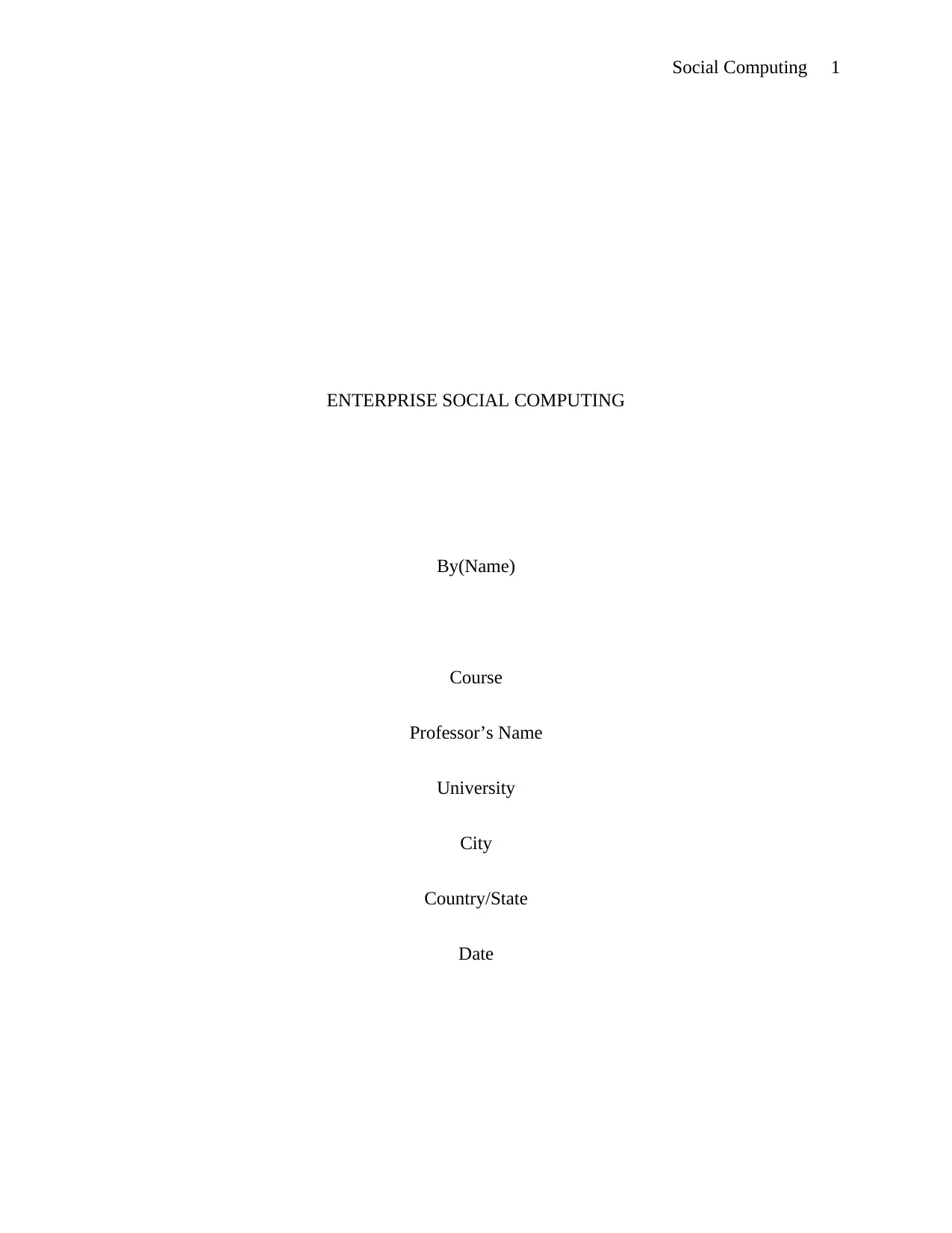
Social Computing 1
ENTERPRISE SOCIAL COMPUTING
By(Name)
Course
Professor’s Name
University
City
Country/State
Date
ENTERPRISE SOCIAL COMPUTING
By(Name)
Course
Professor’s Name
University
City
Country/State
Date
Paraphrase This Document
Need a fresh take? Get an instant paraphrase of this document with our AI Paraphraser
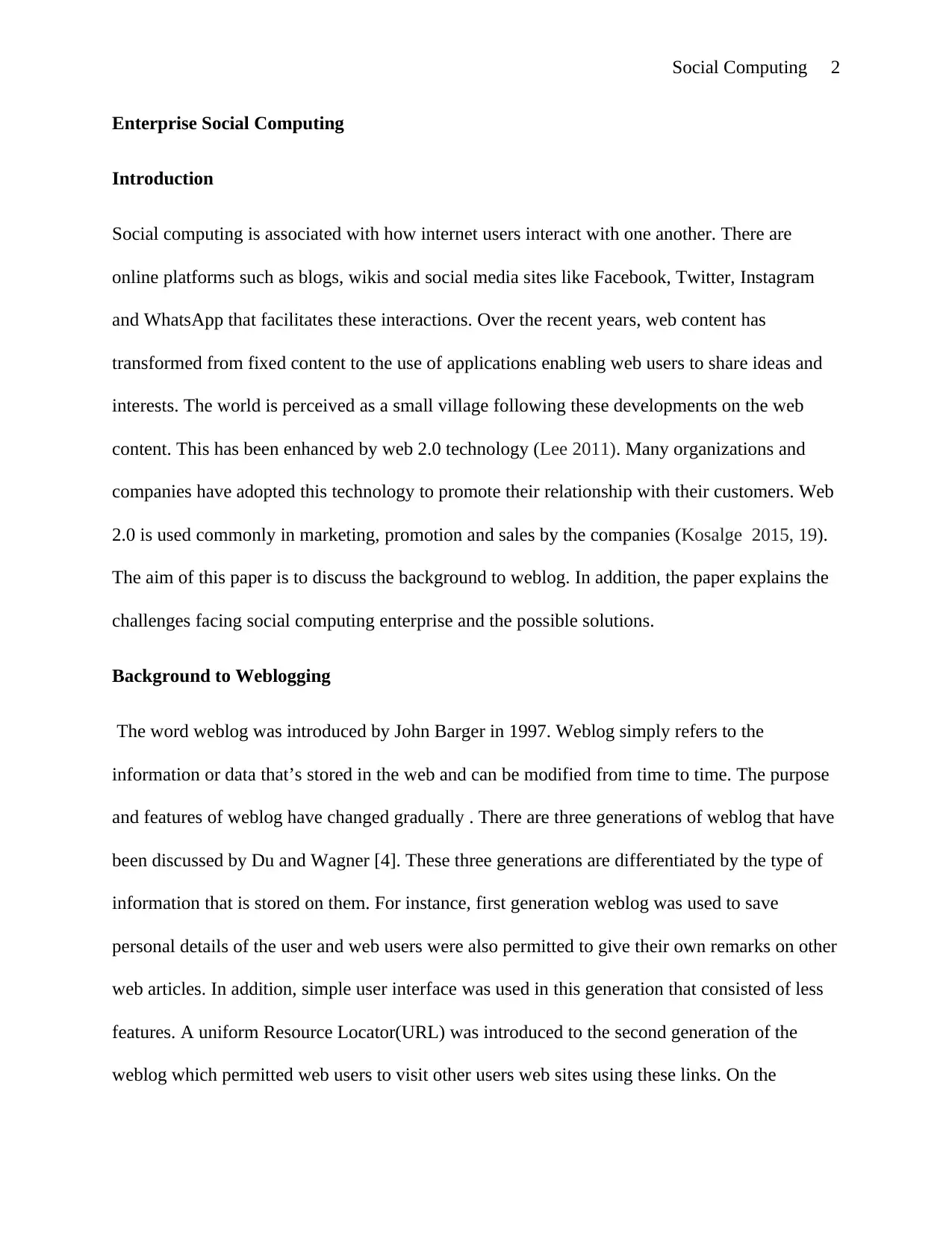
Social Computing 2
Enterprise Social Computing
Introduction
Social computing is associated with how internet users interact with one another. There are
online platforms such as blogs, wikis and social media sites like Facebook, Twitter, Instagram
and WhatsApp that facilitates these interactions. Over the recent years, web content has
transformed from fixed content to the use of applications enabling web users to share ideas and
interests. The world is perceived as a small village following these developments on the web
content. This has been enhanced by web 2.0 technology (Lee 2011). Many organizations and
companies have adopted this technology to promote their relationship with their customers. Web
2.0 is used commonly in marketing, promotion and sales by the companies (Kosalge 2015, 19).
The aim of this paper is to discuss the background to weblog. In addition, the paper explains the
challenges facing social computing enterprise and the possible solutions.
Background to Weblogging
The word weblog was introduced by John Barger in 1997. Weblog simply refers to the
information or data that’s stored in the web and can be modified from time to time. The purpose
and features of weblog have changed gradually . There are three generations of weblog that have
been discussed by Du and Wagner [4]. These three generations are differentiated by the type of
information that is stored on them. For instance, first generation weblog was used to save
personal details of the user and web users were also permitted to give their own remarks on other
web articles. In addition, simple user interface was used in this generation that consisted of less
features. A uniform Resource Locator(URL) was introduced to the second generation of the
weblog which permitted web users to visit other users web sites using these links. On the
Enterprise Social Computing
Introduction
Social computing is associated with how internet users interact with one another. There are
online platforms such as blogs, wikis and social media sites like Facebook, Twitter, Instagram
and WhatsApp that facilitates these interactions. Over the recent years, web content has
transformed from fixed content to the use of applications enabling web users to share ideas and
interests. The world is perceived as a small village following these developments on the web
content. This has been enhanced by web 2.0 technology (Lee 2011). Many organizations and
companies have adopted this technology to promote their relationship with their customers. Web
2.0 is used commonly in marketing, promotion and sales by the companies (Kosalge 2015, 19).
The aim of this paper is to discuss the background to weblog. In addition, the paper explains the
challenges facing social computing enterprise and the possible solutions.
Background to Weblogging
The word weblog was introduced by John Barger in 1997. Weblog simply refers to the
information or data that’s stored in the web and can be modified from time to time. The purpose
and features of weblog have changed gradually . There are three generations of weblog that have
been discussed by Du and Wagner [4]. These three generations are differentiated by the type of
information that is stored on them. For instance, first generation weblog was used to save
personal details of the user and web users were also permitted to give their own remarks on other
web articles. In addition, simple user interface was used in this generation that consisted of less
features. A uniform Resource Locator(URL) was introduced to the second generation of the
weblog which permitted web users to visit other users web sites using these links. On the
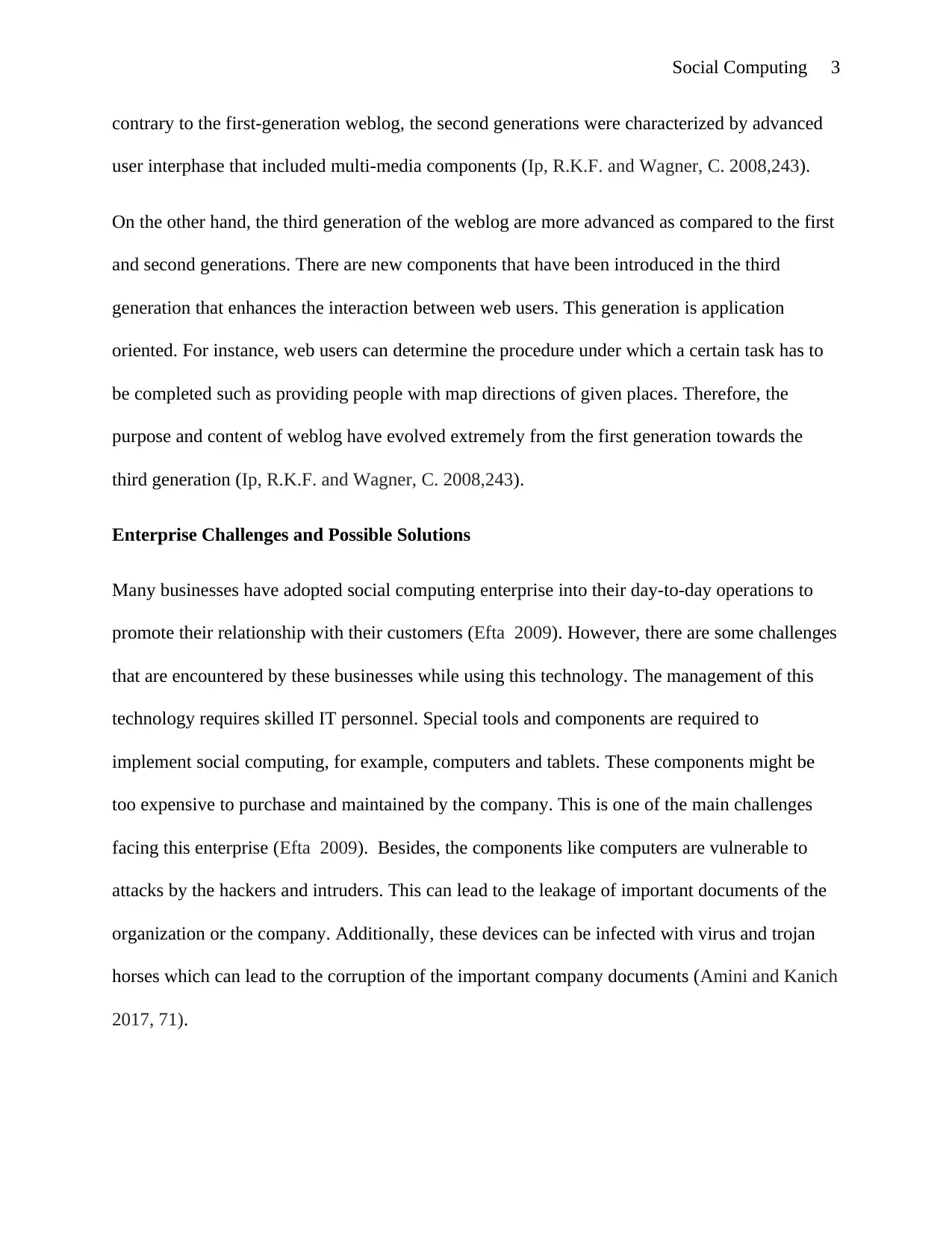
Social Computing 3
contrary to the first-generation weblog, the second generations were characterized by advanced
user interphase that included multi-media components (Ip, R.K.F. and Wagner, C. 2008,243).
On the other hand, the third generation of the weblog are more advanced as compared to the first
and second generations. There are new components that have been introduced in the third
generation that enhances the interaction between web users. This generation is application
oriented. For instance, web users can determine the procedure under which a certain task has to
be completed such as providing people with map directions of given places. Therefore, the
purpose and content of weblog have evolved extremely from the first generation towards the
third generation (Ip, R.K.F. and Wagner, C. 2008,243).
Enterprise Challenges and Possible Solutions
Many businesses have adopted social computing enterprise into their day-to-day operations to
promote their relationship with their customers (Efta 2009). However, there are some challenges
that are encountered by these businesses while using this technology. The management of this
technology requires skilled IT personnel. Special tools and components are required to
implement social computing, for example, computers and tablets. These components might be
too expensive to purchase and maintained by the company. This is one of the main challenges
facing this enterprise (Efta 2009). Besides, the components like computers are vulnerable to
attacks by the hackers and intruders. This can lead to the leakage of important documents of the
organization or the company. Additionally, these devices can be infected with virus and trojan
horses which can lead to the corruption of the important company documents (Amini and Kanich
2017, 71).
contrary to the first-generation weblog, the second generations were characterized by advanced
user interphase that included multi-media components (Ip, R.K.F. and Wagner, C. 2008,243).
On the other hand, the third generation of the weblog are more advanced as compared to the first
and second generations. There are new components that have been introduced in the third
generation that enhances the interaction between web users. This generation is application
oriented. For instance, web users can determine the procedure under which a certain task has to
be completed such as providing people with map directions of given places. Therefore, the
purpose and content of weblog have evolved extremely from the first generation towards the
third generation (Ip, R.K.F. and Wagner, C. 2008,243).
Enterprise Challenges and Possible Solutions
Many businesses have adopted social computing enterprise into their day-to-day operations to
promote their relationship with their customers (Efta 2009). However, there are some challenges
that are encountered by these businesses while using this technology. The management of this
technology requires skilled IT personnel. Special tools and components are required to
implement social computing, for example, computers and tablets. These components might be
too expensive to purchase and maintained by the company. This is one of the main challenges
facing this enterprise (Efta 2009). Besides, the components like computers are vulnerable to
attacks by the hackers and intruders. This can lead to the leakage of important documents of the
organization or the company. Additionally, these devices can be infected with virus and trojan
horses which can lead to the corruption of the important company documents (Amini and Kanich
2017, 71).
⊘ This is a preview!⊘
Do you want full access?
Subscribe today to unlock all pages.

Trusted by 1+ million students worldwide
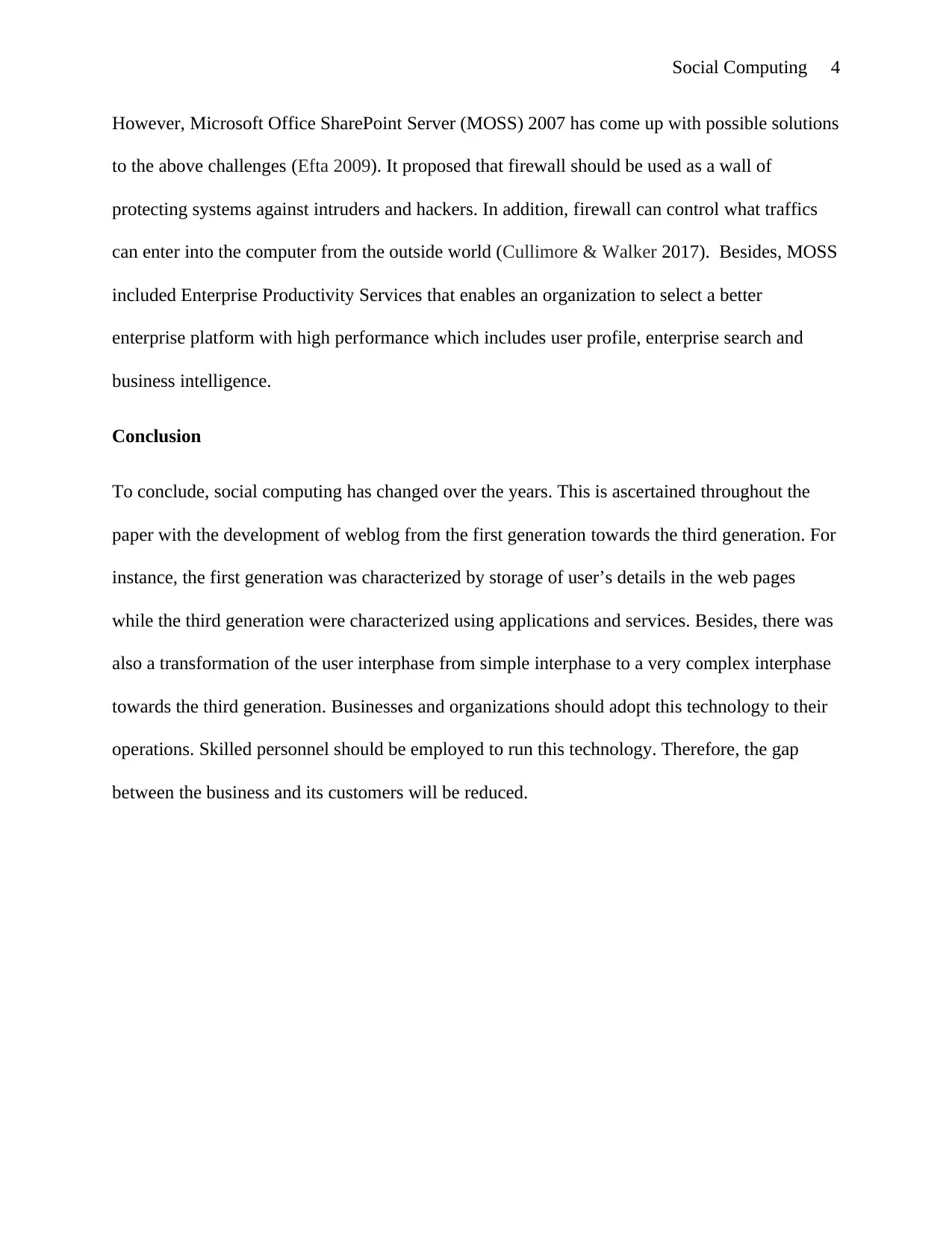
Social Computing 4
However, Microsoft Office SharePoint Server (MOSS) 2007 has come up with possible solutions
to the above challenges (Efta 2009). It proposed that firewall should be used as a wall of
protecting systems against intruders and hackers. In addition, firewall can control what traffics
can enter into the computer from the outside world (Cullimore & Walker 2017). Besides, MOSS
included Enterprise Productivity Services that enables an organization to select a better
enterprise platform with high performance which includes user profile, enterprise search and
business intelligence.
Conclusion
To conclude, social computing has changed over the years. This is ascertained throughout the
paper with the development of weblog from the first generation towards the third generation. For
instance, the first generation was characterized by storage of user’s details in the web pages
while the third generation were characterized using applications and services. Besides, there was
also a transformation of the user interphase from simple interphase to a very complex interphase
towards the third generation. Businesses and organizations should adopt this technology to their
operations. Skilled personnel should be employed to run this technology. Therefore, the gap
between the business and its customers will be reduced.
However, Microsoft Office SharePoint Server (MOSS) 2007 has come up with possible solutions
to the above challenges (Efta 2009). It proposed that firewall should be used as a wall of
protecting systems against intruders and hackers. In addition, firewall can control what traffics
can enter into the computer from the outside world (Cullimore & Walker 2017). Besides, MOSS
included Enterprise Productivity Services that enables an organization to select a better
enterprise platform with high performance which includes user profile, enterprise search and
business intelligence.
Conclusion
To conclude, social computing has changed over the years. This is ascertained throughout the
paper with the development of weblog from the first generation towards the third generation. For
instance, the first generation was characterized by storage of user’s details in the web pages
while the third generation were characterized using applications and services. Besides, there was
also a transformation of the user interphase from simple interphase to a very complex interphase
towards the third generation. Businesses and organizations should adopt this technology to their
operations. Skilled personnel should be employed to run this technology. Therefore, the gap
between the business and its customers will be reduced.
Paraphrase This Document
Need a fresh take? Get an instant paraphrase of this document with our AI Paraphraser
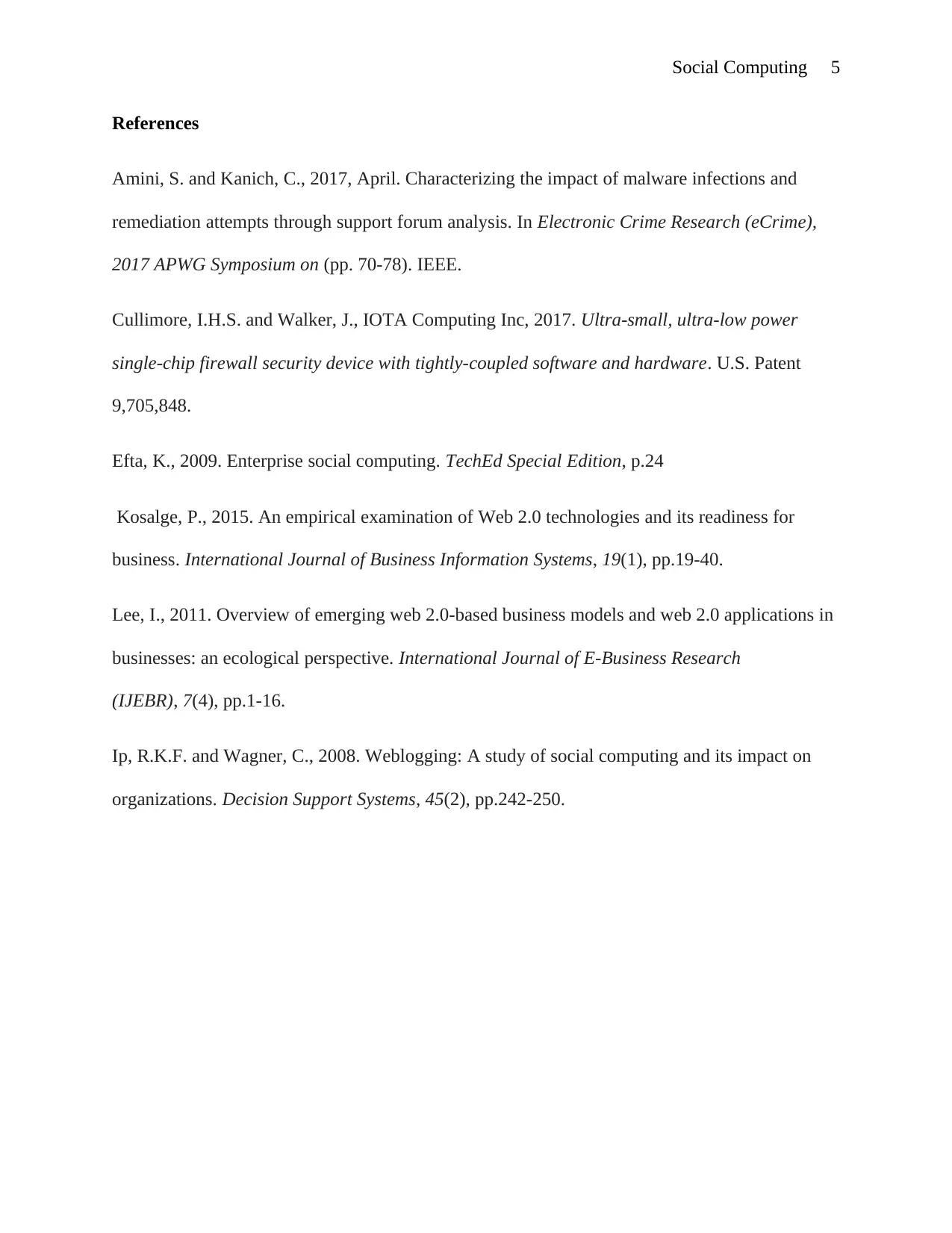
Social Computing 5
References
Amini, S. and Kanich, C., 2017, April. Characterizing the impact of malware infections and
remediation attempts through support forum analysis. In Electronic Crime Research (eCrime),
2017 APWG Symposium on (pp. 70-78). IEEE.
Cullimore, I.H.S. and Walker, J., IOTA Computing Inc, 2017. Ultra-small, ultra-low power
single-chip firewall security device with tightly-coupled software and hardware. U.S. Patent
9,705,848.
Efta, K., 2009. Enterprise social computing. TechEd Special Edition, p.24
Kosalge, P., 2015. An empirical examination of Web 2.0 technologies and its readiness for
business. International Journal of Business Information Systems, 19(1), pp.19-40.
Lee, I., 2011. Overview of emerging web 2.0-based business models and web 2.0 applications in
businesses: an ecological perspective. International Journal of E-Business Research
(IJEBR), 7(4), pp.1-16.
Ip, R.K.F. and Wagner, C., 2008. Weblogging: A study of social computing and its impact on
organizations. Decision Support Systems, 45(2), pp.242-250.
References
Amini, S. and Kanich, C., 2017, April. Characterizing the impact of malware infections and
remediation attempts through support forum analysis. In Electronic Crime Research (eCrime),
2017 APWG Symposium on (pp. 70-78). IEEE.
Cullimore, I.H.S. and Walker, J., IOTA Computing Inc, 2017. Ultra-small, ultra-low power
single-chip firewall security device with tightly-coupled software and hardware. U.S. Patent
9,705,848.
Efta, K., 2009. Enterprise social computing. TechEd Special Edition, p.24
Kosalge, P., 2015. An empirical examination of Web 2.0 technologies and its readiness for
business. International Journal of Business Information Systems, 19(1), pp.19-40.
Lee, I., 2011. Overview of emerging web 2.0-based business models and web 2.0 applications in
businesses: an ecological perspective. International Journal of E-Business Research
(IJEBR), 7(4), pp.1-16.
Ip, R.K.F. and Wagner, C., 2008. Weblogging: A study of social computing and its impact on
organizations. Decision Support Systems, 45(2), pp.242-250.

Social Computing 6
⊘ This is a preview!⊘
Do you want full access?
Subscribe today to unlock all pages.

Trusted by 1+ million students worldwide
1 out of 6
Related Documents
Your All-in-One AI-Powered Toolkit for Academic Success.
+13062052269
info@desklib.com
Available 24*7 on WhatsApp / Email
![[object Object]](/_next/static/media/star-bottom.7253800d.svg)
Unlock your academic potential
Copyright © 2020–2025 A2Z Services. All Rights Reserved. Developed and managed by ZUCOL.





